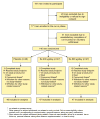Oral selenium supplementation has no effect on prostate-specific antigen velocity in men undergoing active surveillance for localized prostate cancer
- PMID: 20647337
- PMCID: PMC4533875
- DOI: 10.1158/1940-6207.CAPR-09-0143
Oral selenium supplementation has no effect on prostate-specific antigen velocity in men undergoing active surveillance for localized prostate cancer
Abstract
The Nutritional Prevention of Cancer trial showed a 52% lower incidence of prostate cancer in men supplemented with selenium. As a result, our study was designed to assess whether selenium supplementation attenuates the progression of prostate cancer. A phase 2 randomized, double-blind, placebo-controlled clinical trial was conducted in men with localized nonmetastatic prostate cancer who had elected to forgo active treatment and be followed by active surveillance. A total of 140 men were randomized to placebo (n = 46), 200 microg/d (n = 47), or 800 microg/d (n = 47) selenium p.o. (as selenized yeast) and followed every 3 months for up to 5 years. Prostate-specific antigen (PSA) velocity was used as a marker of prostate cancer progression and was estimated using mixed-effects regression. Adjusting for age, body mass index, baseline selenium, smoking, baseline PSA, race, PSA method, and Gleason score, PSA velocities for the 200 microg/d and 800 microg/d treatment groups were not statistically significantly different from placebo (P = 0.32 and P = 0.61, respectively). In the highest quartile of baseline selenium, men supplemented with 800 microg selenium showed statistically significantly higher PSA velocity as compared with placebo (P = 0.018). Selenium supplementation did not show a protective effect on PSA velocity in subjects with localized prostate cancer. On the contrary, supplementation with high-dose selenium was observed to be a risk factor for increased PSA velocity in men with high baseline plasma selenium concentrations.
2010 AACR.
Figures




References
-
- ACS. Cancer Facts & Figures 2009. Atlanta: American Cancer Society; 2009.
-
- Fowler FJ, Jr, Barry MJ, Lu-Yao G, Roman A, Wasson J, Wennberg JE. Patient-reported complications and follow-up treatment after radical prostatectomy. The National Medicare Experience: 1988–1990 (updated June 1993) Urology. 1993;42:622–9. - PubMed
-
- Potosky AL, Legler J, Albertsen PC, et al. Health outcomes after prostatectomy or radiotherapy for prostate cancer: results from the Prostate Cancer Outcomes Study. J Natl Cancer Inst. 2000;92:1582–92. - PubMed
-
- Eisenberger M, Partin A. Progress toward identifying aggressive prostate cancer. N Engl J Med. 2004;351:180–1. - PubMed
Publication types
MeSH terms
Substances
Grants and funding
LinkOut - more resources
Full Text Sources
Medical
Research Materials
Miscellaneous

